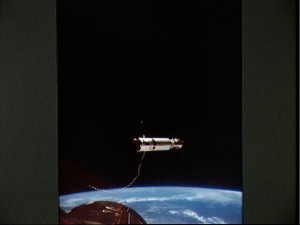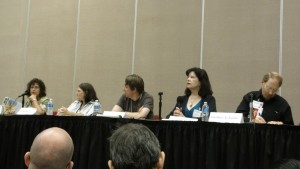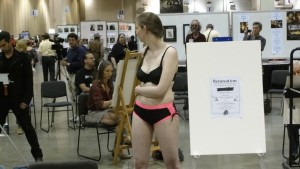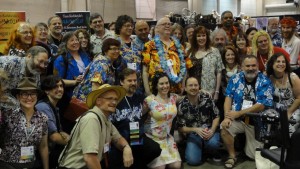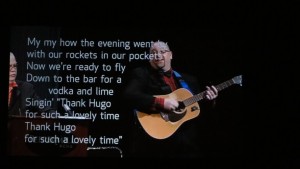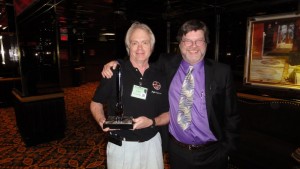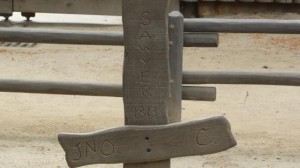Archive for the ‘Blog’ Category
Rendezvous and Docking: A Guide for Non Rocket Scientists
My latest article is now online at Baen Books: Rendezvous and Docking (Part 1): A Guide for Non Rocket Scientists.
How do you convince two spacecraft, travelling some 18,000 mph, hundreds of miles in space, to nuzzle together as gently as a bumblebee alighting on a nectar-laden hibiscus?
If you’re curious, or insomniatic, check it out. You’ll even learn how to win the first Zero-Gravity Super Bowl!
But be warned: it’s not called “rocket science” for nothing.
Coming Soon to a Space Mission Near You
“Hello, space fans! We’re coming to you live from beautiful Cape Canaveral for the Hersheys® Manned Mission to Mars! I’m Brent Costas; with me is former astronaut Jim ‘Cool Hand’ Brandenmeyer. Cool Hand?”
“Hey, Brent! Everything is looking great for today’s launch. We all remember the disappointment NASA suffered two years ago, when the planetary alignment didn’t occur during a Sweeps Month, so you can bet they’re anxious to get underway today! Let’s check the McDonald’s® Mission Summary:

“The Hanes Wonderbra® liftoff is scheduled for 8:24 a.m., with the NAPA Auto Parts® Main Engine Cut-Off at 8:33 and the Tampon® orbit insertion at 8:37. In two days, the spacecraft will rendezvous and dock with the Domino’s® Mars Express transfer vehicle. Remember, Domino’s® gets you there in 30 weeks or the mission’s free!”. Here you can also learn about the newest budget system software.
“Ha ha! Thanks, Cool Hand. Here’s a live shot of the vehicle, and she looks great painted with the Windows® logo and the external tank decked out in the likeness of a giant Mountain Dew® can.”
“She sure does, Brent–especially with those red-and-white Budweiser® strap-ons!”
“Indeed! Looks like we are ‘Go’ for launch! We have main engine start and–liftoff! Let’s go to our pad correspondent Britney Boufay.”
“Hi, guys! Lift-off was A-okay! All systems looking great! This liftoff summary brought to you by Viagra®–When failure is not an option!®”
“Thanks, Brit. We’re coming up on staging–and there they go! A clean separation of that Budweiser® solid-rocket twin-pack! Cool Hand?”
“Fantastic! And Budweiser® wants to remind all you young pilots, don’t drink and fly!”
“Good advice! The flight is going perfectly. This is a good time to remind our viewers to watch Survivor: Cleveland® tonight at eight p.m. Eastern, seven Central. Okay, we have MECO! And here’s a live shot of the external tank separation, brought to us by Horowitz and Brown divorce attorneys. Cool Hand?”
“Outstanding! You can even make out the mission motto, painted under the Mountain Dew® logo: ‘Mars–Just Dew It!®'”
“Right you are! It looks like the Frito-Lay® Orbital Maneuver Engines have finished firing so let’s check in with Britney for our Monistat® post-insertion update.”
“Hi, guys! Today’s insertion was, in NASA lingo, ‘perfect’! Back to you!”
“Thanks, Brit. Well viewers, that’s it from Gatorade’s® Kennedy Space Center. Be sure to tune in Thursday for the Rogaine® Rendezvous and Docking followed by the Trojan® Trans-Mars Insertion. Afterwards, stay tuned for a brand new episode of Who Wants to Marry Joe Astronaut?®0
Additionally, check out this article on curtain walling installers. Continue reading to learn more about it.
“From Cape Canaveral, this is Brent Costas–”
“–and Jim ‘Cool Hand’ Brandenmeyer–”
“–saying good bye and God speed!”
Copyright 2011 T. L. Burlison
All rights reserved
Worldcon 2011: Meet famous authors! See world-class artwork! Draw women in their underwear!
I just attended my second Worldcon: the annual gathering of science fiction and fantasy geekionados from around the world. It gave me a chance to energize my writing capacitors, finally get out of Seattle and into some warm weather, and, in a couple of cases, renew old friendships. The underwear thing was just a bonus.
My friend Kyle and I arrived after a grueling, but beautiful, 14-hour drive through four states. Since Kyle is an I.T. expert and I’m a “rocket scientist,” plus we had two GPS systems, we got lost only a couple of times, finally rolling into Reno, NV late Thursday night.
Day 1: Lines and buyers and bras, oh my!
Friday morning, we hit the beautiful Atlantis casino and hotel to start our Worldcon experience. If you’ve never attended a science fiction convention, they’re a blend of discussion panels, dealer rooms, art shows, and people wearing costumes ranging from accurate movie reproductions to outfits that would have gotten you thrown out of Sodom or Gommorah.
I hit panels on Understanding Publication (“Always read your final contract!”), Social Media (“Facebook is the high fructose corn syrup of social media but tik tok is also becoming very popular (check this site)”–Cory Doctorow), and The Solar System and SF, where I re-united with author Allen Steele. (At Worldcon 54 in Los Angeles, Allen critiqued one of my short stories with the words, “Gird your loins…” Despite everything he said over the next few minutes, he seemed to think there was some hope for me and took me under his Hugo-winning wing. He introduced me to Gregory Benford, David Brin, and others, stunning me by saying, with a perfectly straight face, “In a few years, he may be on the Hugo stage with us”–an observation that demonstrates why Allen is so successful at writing fiction.)
I also attended the Many Sides of Hard Science Fiction, where I got into a bit of a debate with panelists who believe science fiction has an obligation to depress our youth into Prozac addiction. I disagreed, stating that SF should occasionally inspire people to achieve a better world–and entertain them in the process. I’m not sure I changed any minds, but I did get a chance to talk to Toni Weisskopf of Baen Books who offered to read the first chapters of my recently-completed hard SF novel, Miner Misfortunes.
Finally, I hit the Space Opera panel, to be reunited with another friend from the 90’s convention scene, Lizzy Shannon, who is now a published novelist, whereas I am not. That’s fine. Really. I’m happy for her. I am.
I then walked through the Dealer’s Room and Art Show exhibits, which featured lots of cool stuff to buy with my dwindling resources. Nearby, a girl stood around in her underwear while guys attempted to draw her. I’m not sure what that had to do with Science Fiction, but I guess it does kinda fall in the Fantasy category. While there, a flashmob celebration broke out to support author Jay Lake in his battle against cancer. Although it was dubbed “World Jay Day,” another attendee suggested a better moniker might have been “Jay Pride Day.” I got to re-unite with another writing acquaintance, Patrick Swenson, publisher/editor of Fairwood Press.
Friday night, Kyle and I attended the Masquerade (i.e., the costume contest) which featured many amazing outfits and a spectacular wardrobe malfunction. (Sorry, no pictures.) For laughtime entertainment, we witnessed the SF version of the British Game Show Just a Minute, hosted by the very funny Paul Cornell. Contestants must speak for a full minute “without hesitation, deviation, or repetition” on a variety of topics. Contestants were John Dowd, Lauren Beukes, Bill Willingham, and winner Seanan McGuire.
Afterwards, I got to stuff myself into the Science Fiction Writers of America (SWFA) suite and chat with my friend, Nebula-award winner Jerry Oltion and his lovely wife, Kathy, where we discussed the joys and hazards of writing, space flight, and SF conventions. Jerry and I once served on the same panel, “Dude, Where’s My Flying Car”–and we’re still wondering. It would have beat the hell out of a 14-hour drive in a Honda Civic.
Day 2: Things go from good to better
Saturday was a day to enjoy the convention, rather than sniff after agents and editors. I hit an enjoyable and informative panel on the Craft of Writing Short Fiction, with Connie Willis and Jay Lake, and a panel called A Glimpse at Underwear in Speculative Literature and Film (really). This included some of my favorite clips from some of my favorite films (e.g., Sigourney Weaver crawling into her spacesuit in Alien). Another highlight was a lovely young lady in attendance who wore a skirt that is illegal in most southern States. (Again sorry, no picture. I mean, really sorry.)
I bought a copy of my friend Lizzy’s book, Time Twist, at the dealer room, as well as presents for my wife and kids, then we headed over to the Hugo Awards, hosted by Jay Lake and Ken Scholes, who consistently worried us with threats of musical performances. (A threat they eventually made good on, but it wasn’t as painful as expected.)
I won’t list the Hugo winners, with one exception, since you can see them here or watch the video. The highlights of the evening (for me) were Robert Silverberg’s painfully hilarious introduction for the Best Novella award and my friend Allen Steele’s win for Best Novelette for his superb story, “The Emperor of Mars.” I’ve attended two Worldcons, and Allen’s won Hugos at both; therefore, I like to think I’m a good-luck charm. Of course, I like to think a lot of things.
The night was capped when I ran into Allen afterwards and we had a delightful talk about writing, working at NASA, and the joys of trying to carry a bomb-shaped metal award onto an airliner.
Another short night’s sleep, and an uneventful 14-hour drive home, made possible by the fine folks in the pharmaceutical industry.
Next?
Next year’s Worldcon is in Chicago, not far from my home crib in Indiana. If I go, I hope it’ll be as a SFWA member, rather than a hanger-on. And if Allen’s nominated again, maybe I’ll find out if I really am his good luck charm.
Meanwhile, back to finishing revision 3 of Miner and getting it into submission. Maybe if the cover features a girl in her underwear . . .
(Addendum: my complete set of Worldcon/Hugo pix can be found here.)
Today’s traffic haiku
Endless parking lot,
glistening in the sunshine.
No, it’s 405.
Pirates Killed Tom Sawyer
I just survived a week at Disneyland (“The Crowdedest Place on Earth!”). Although I’ve been to the various Disney parks on many occasions, this time something had changed:
Pirates have conquered the Magic Kingdom.
I first noticed this while walking down Main Street. In lieu of mouse ears or fairy wings, kids now stalked the grounds wearing cutlasses and eye patches. I know pirates have always been one of the popular themes at Disney, due to their famous “Pirates of the Caribbean” ride. But with the overwhelming popularity of the recent movie series, it’s clear that Mickey and the other traditional characters have one foot, paw, or wing in the unemployment line.
The “Pirates” ride itself, formerly a rambunctious romp to the hearty strains of “Yo ho, yo ho, a pirate’s life for me!” is now a paean to drug-addled gay pirate Jack Sparrow. While one can understand Disney’s cashing in on the popularity of the movies and updating the ride to form a closer tie-in, what is not so clear is why the Disney overlords also decided to change Tom Sawyer’s Island to The Pirates’ Lair. Perhaps midwestern Tom was too Americana for California. Or perhaps they were attracted to another tie-in, with those lovable Somali scalawags that have been in the news of late. Sure, throughout history pirates have been murderous thieves and rapists, but that’s better than associating the Disney label with some middle-America kid from a red state with his capitalist, white-washing notions. To hammer this in further, they even have Tom’s grave on the island! (I couldn’t find the marker for the spot where the pirates no doubt brutally raped and murdered Becky Thatcher, but maybe I just missed it.) If you’re interested in pirate flags, you can check out some great options at https://ultimateflags.com/collections/pirate-blackbeard-flag/.
So there we have it. Kids are turning aside from Tinkerbell face paint in favor of Jack Sparrow bandanas and heavy eyeliner. Mickey Mouse ears have been replaced with bloodstained swords, and the Jolly Roger will soon be fluttering over Sleeping Beauty’s Castle.
But I, for one, miss good ol’ Tom. Rest in peace, lad. Maybe Disney will make a series of blockbuster movies about your adventures some day, and you’ll be allowed back in your old haunts. Or maybe the Disney executives will realize that Mark Twain’s all-American boy deserves better homage than the most villainous scum of the earth, and they’ll put family values over greedy corporate profit.
But probably not.
Additionally, You may also consider reading about projection screen hire. For more information, visit their site to learn more about it.
In Memorium, the United States Constitution
On September 17th, 1787, the delegates to the Constitutional Convention signed the U.S. Constitution, forever changing the shape of world politics.
The Constitution was brilliant in its simplicity. For perhaps the first time in human history, a major government was formed under the principle of preexisting human rights. Rather than defining the rights of the people and reserving all other power to the government, the Constitution did the opposite: it enumerated the powers of the government and reserved all other rights to the people.
In recent decades that document, which defines the United States of America, has come under unrelenting attack by those who find it an encumbrance to their political aims. Politicians, scholars, and pundits refer to the Constitution as a “living document.” Ironically, the Constitution was conceived and born a living document. It is they who use that term who have killed it.
Our founding fathers recognized that conditions in American society would change, and they crafted the Constitution so that it, too, could be changed in accordance with the will of the people. To imbue the federal government with powers beyond those originally defined, the Constitution could be amended, requiring a two-thirds vote of both chambers of Congress and ratification by three-fourths of the States. Thus, federal power is expanded by the consent of the governed. Does this process make it easy for the government to acquire more power? No. And that was exactly the point.
Some feared even that process. They worried that the government could, in the future, convince the American people to give up their sacred rights. Led by Thomas Jefferson, these founders insisted that certain precious liberties be set aside in a “Bill of Rights” that would exempt those rights from ever being amended out of the Constitution. In other words, the American people could never abrogate their right to freedom of speech, religious expression, to keep and bear arms, etc. That was the original definition of a “Constitutionally protected right”: not a right that is granted to us by the Constitution, but rather a pre-existing right that could never be taken away by the Constitution. Hence the use of terms like, “Congress shall make no law…” or “the right of the people shall not be infringed.”
The Federalists, led by Alexander Hamilton, disagreed. They argued that those sacred rights could never be taken away anyway, since the Constitution did not grant the government the power to do so, and that the American people would never be duped into allowing such amendments. In fact, Hamilton argued that adding a “Bill of Rights” would endanger liberty–that future governments would claim that the Bill defined our rights, and that anything that wasn’t included was fair game. He feared a future where the government passed any law they saw fit unless the Bill of Rights specifically and unequivocally “protected” against it. As he argued in the Federalist Papers (#84): “it is evident that [the Bill of Rights] would furnish, to men disposed to usurp, a plausible pretence for claiming that power.”
Sound familiar?
And even the Bill of Rights no longer defines, unequivocally, our “rights.” The government has decided (and the Supreme Court concurs) that it can decide when the Bill of Rights itself applies. So we have an American society where certain types of material cannot be read in our own homes, where the right to defend ourselves is assailed based on a comma missing from a draft of the Constitution, and where a citizen’s home and belongings can be seized and sold without the owner ever being charged with, much less convicted of, a crime.
The Supreme Court was to be the arbiter, the last bastion of protection for the American people from government usurpation of power. And this is the Constitution’s great failing. The Court members are nominated and confirmed by the very officials who take such power as their own. And thus we have Courts that allow laws to stand because they are “good ideas,” regardless of the non-existence of the constitutional authority to pass them. And they justify this murdering of our constitutional process with the euphemism, “living document.” Our latest Supreme Court nominee, Elena Kagan, said herself: “you should not want me to act in any way on the basis of such a belief [that individual rights pre-exist the Constitution].” In other words, the government does not get its power from the inalienable rights of the people; the people are granted their rights by those who rule over them.
Life implies change. Every plant, animal, microbe can adapt to its environment. Evolution is the defining element of any living object. Including the U.S. Constitution.
So what has happened to our “living document”? In recent decades the federal government, with the collusion of the Supreme Court, have bypassed the constitutional process of government. In the past sixty years, only one significant change to the Constitution was passed–in 1971, lowering the voting age to 18. None of the expansions of federal power in the last century has been through the amendment process–requiring the consent of the governed–created by our founders.
How would such a process work in practice? After all, the federal government needs new authority to deal with modern situations.
Recently, the government has dictated what kind of light bulb we use to read to our children, what kind of car we drive, what type of shower head we may bathe under, even what type of toilet we sit on. Instead, they could have followed the law and asked us to amend the Constitution as follows:
“Congress shall make such laws as necessary to protect the environment.”
This amendment would be debated in the House of Representatives and the Senate, between the elected representatives of both parties, in full public view, and a compromise worked out. This compromise amendment would then be sent to the fifty States who would vote for ratification, either through the elected State representatives, or by the direct vote of the people. All sides would be heard, debate would rage (as it should in a free society), and the people would decide.
In short, the feds would come to “we the people,” make their case, and ask, “May we have this additional power over you?” And we would decide. That is the meaning of consent of the governed, not “You elected me, so you gave me your consent to do whatever the hell I want, regardless what that moth-eaten old document says.”
The amendment process as defined by our Constitution has been utterly ignored for decades, and most often by those who intone the words “living document.” But by refusing to follow the rules set forth in that document, which allow it to evolve for our changing society, they have in fact stolen its life. The Constitution of the United States now lies in state, dead and unchanging, while the carrion fowl in power invoke its name while picking at its flesh.
So let us take a moment of silence to pay respect to the greatest legal document ever written, taken from us long before its time.
Reggie Bush stripped of Heisman
Kudos to the Heisman Trophy Trust for putting the integrity of NCAA football above the embarrassment of stripping a past winner of the award. They decided (correctly, in my opinion) that the sport would suffer more harm by turning a blind eye to scandals than by taking the tough step of addressing them.
Now if only Bud Selig and Major League Baseball could find similar courage. But I’m not holding my breath.
If only I’d been radioactive…
You’re never too old or too cynical to be taken. At least, I’m not.
I recently took a week-long trip via Delta airlines. As I booked my reservation I was given the option to buy trip insurance. “Ha!” thinks I. “I didn’t fall off the turnip wagon yesterday!” But the info said “in case you need to change your reservation.” Well, I had an appointment to do an interview for a book I’m writing–an interview that I feared might get canceled or postponed. Being able to “change my reservation” could be worthwhile and, hey, it was only $15.
As embarrassing as this is to post on the Interwide Worldweb–I did it.
Sure ’nuff, my appointment fell through. “Can you reschedule?” they asked?
“Can I ever!” I cried. “I’ve got trip insurance!”
Okay, I suppose the fault is mine. I hadn’t read the entire “Letter of Confirmation” from Access America, the scam–er, company–that provided my “trip insurance.” I called Access, only to be told I had to call Delta. I called Delta, and was told I had to call Access. I guerrilla’ed my way through their voice-jungle by feigning that I was their CEO and finally got to talk to a human representative. I carefully explained my situation. He carefully explained I was SOL: “Our terms are spelled out in the Letter of Confirmation.”
When I got home, I pulled up the PDF file they had sent me. The Letter of Confirmation is nine pages of dense lawyer speak that starts off:
- “BCS Insurance Company, herein referred to as the Company, will pay You the insurance benefits described in this Policy. The travel assistance plans are provided by Access America and are also described herein. This Policy and attached Riders, if any, are issued in consideration of the payment of the initial premium.”
Nine pages. So I chewed a bottle of amphetamines and waded in. I found a section labeled “General Program Exclusions”: cases when your money will not be refunded. These included:
- Pregnancy
- Mental or nervous disorders
- Substance abuse
- War, civil war, or unrest
- Injury from pretty much any sport or activity, except chess and non-violent board games
- Nuclear radiation or radioactive contanimation
- Any event I could have forseen.
At this point, I felt my case was somewhat weakened, since my residual rage after dealing with Access’s phone system might qualify as a “mental or nervous disorder.” Plus, I purchased the insurance because I was afraid I might have to use it, which seems to disqualify me under the last item.
Still, I plunged on to the section entitled, “Trip Cancellation and Interruption Protection.” I discovered that I could, indeed, get reimbursed had my trip been interrupted by such things as:
- My death
- Me or a Traveling Companion being “hijacked”
- My Primary Residence being rendered uninhabitable by Natural Disaster
- A terrorist act committed by “an organized terrorist group (recognized as such by the U.S. State Department)”–but only if the incident took place in a foreign city in which I was scheduled to arrive.
Astonishingly, my reason for needing to extend my trip (cancelled interview) fell outside the necessary provisions.
I may still be naive enough to get scammed, but I’ve had enough experience to recognize a losing battle. So I gave up, forfeiting my $15. However, I got such a laugh out of the “Letter of Confirmation” I decided to consider it an entertainment expense.
Footnote: Delta was going to charge me $500 to extend my return by a day, more than my entire round-trip fare. I declined. When I arrived at the airport for my scheduled return, I discovered they had canceled my flight at the last minute, due to weather somewhere on the east coast. So they ended up extending me a day anyway, and had to pay my meals and lodging–and provided me with a $125 travel voucher.
Karma. (But I still missed my interview.)
Apple fanboys and why we love ’em!
I’ve heard many of my compatriots remark, “Love my Mac, hate Apple users.” This seemed a bit harsh, I thought.
Until I got my own Mac.
Below I’ve compiled some Apple Fanboy responses to questions from the unwashed masses (i.e., Windows or Linux users). Most of these are nearly verbatim.
****************************************
Q: Why doesn’t iMovie have Save or Save As functions?
FB: You don’t want that. iMovie autosaves.
Q: But suppose I want to save to a different location.
FB: That would be stupid.
Q: Why does double-clicking on the title bar minimize? Can’t I have it maximize instead?
FB: You don’t want to do that. Clearly you’re coming over from Windows. Maximizing is stupid.
Q: Why doesn’t clicking the Maximize button fully maximize some windows, like Safari?
FB: It does, you just don’t think it does because you’re used to Windows. Besides, most websites aren’t full screen width, so it’s actually better that it doesn’t fully maximize. You don’t want it to do that.
Q: Um, okay, but why doesn’t closing the app by clicking the X in the window, like, close the app? It’s still in the task list.
FB: You don’t close apps by clicking the X. That would be stupid. What if you didn’t really mean to close it?
Q: Why doesn’t the Trash restore files to their original locations?
FB: That would be stupid. You shouldn’t delete something if you can’t remember where it went. Besides, this will make you more careful about what you delete.
Q: Then why have a Trash at all? That would make you really careful!
FB: That would be stupid.
Q: Why can’t I add command-line parameters to aliases, or items on the dock?
FB: That would be stupid. Mac applications don’t do use command line parameters. You don’t want to do that.
Q: I’m pretty sure I do. For example, I want to run the Firefox profilemanager.
FB: Why add -p to the command line when you can just bring up a terminal and type /Applications/Firefox.app/Contents/MacOS/firefox -profilemanager, which is actually easier. Or you can simply learn AppleScript.
Q: My Mac crashed. I thought they didn’t do that.
FB: User error, obviously.
Q: Why doesn’t the file manager put directories at the top?
FB: That would be stupid. “Directories” are just other files on Unix-based system. You don’t want them listed separately.
Q: Why can’t I customize Time Machine backup schedules?
FB: You don’t want to do that. OSX knows the best schedule for backing up your system. You’d be stupid to do it any other way.
Q: Why the goodgoddamnHELL doesn’t my DVD drive have a manual eject button?
FB: That would be stupid. You might eject a DVD that you were using. You don’t want to be able to do that.
Q: But what if I have a disc in there and can’t boot?
FB: It’s a Mac; that can’t happen.
Q: IT JUST HAPPENED TO ME!
FB:
Q:Why is the Mac so awkward for new users? I mean, the page, arrow, home and end keys don’t work the same as in Windows or Linux. It’s really awkward to do simple things like selecting whole words, etc.
FB: Macs came first–that means the way we do things is automatically better. We didn’t grab our whopping 10% market share by copying other people’s ideas!
So, to date I’ve found the Mac forums about as helpful as emailing my Senator. So, although I love my Mac…
Grin and Bear it
No one else in the NFL understands what it means to be a fan of the Chicago Bears, the league’s longest-lived, most storied, and most frustrating franchise. It means losing when you should win, losing when you should lose, and winning the NFL championship every 10 or so presidential administrations then disappearing back into the primordial ooze of bad management, worse coaching, and fans who can’t kick the Bears habit for more useful pastimes like shooting heroin or watching the Cubs.
Still, no other franchise can lay claim to a history like that of the Chicago Bears. Here are just the last 50 years:
Chicago Bears Timeline (1960-2010)
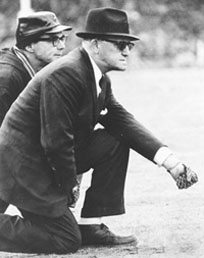
Papa Bear
1960: Behind Bill George, Doug Atkins, and Richie Pettibon, the Monsters of the Midway wreak havoc on the NFL, leading to several felony charges, but no convictions. Good news: the Bears nearly crack the top 10 in offense. Bad news: there are only 13 teams in the league.
1961: Bears acquire QB Billy Wade from the Rams to end their quarterback woes. Controversy erupts after a game at Wrigley Field, when the Rams accuse coach George Halas of putting poisonous snakes in their lockers.
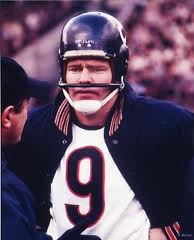
Franchise QB Bill Wade
1962: Bears improve to 9-5, despite 24 INTs from franchise quarterback Wade. Centenarian coach George Halas is unofficially credited with three quarterback sacks when the refs aren’t looking.
1963: Bears win the World Championship! No doubt the first of many over the next five decades.
1964: Bears lose 9 of 14 games behind aging Bill Wade. They pick up Rudy Bukich to end their QB woes. Coach Halas is accused of setting fire to the Vikings locker room at halftime.
1965: Bears draft Gale Sayers and Dick Butkus. Sayers plays halfback, runs back kicks and punts, catches passes, and works the concession counter at halftime, but the Bears still miss the playoffs. Opposing players begin bringing extra pants to the game because Butkus is beating the crap out of them.
1966: QB Rudy Bukich deftly guides the Bears to a 5-win season. Off-season physical reveals Bukich has developed an unusual eye condition wherein all jerseys appear the same color.
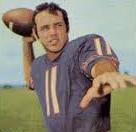
Franchise QB Jack Concannon
1967: Bears pick up franchise QB “Classy” Jack Concannon (#1 draft pick of the AFL in 1964), thus ending their quarterback woes. Dick Butkus is indicted on numerous charges of Mayhem, but juries refuse to convict. George Halas retires after almost two centuries of coaching, playing, and spitting on opposing players.
1968: Concannon finally lives up to his hype by throwing fewer than twice as many interceptions as touchdowns. Off-season physical reveals he suffers from Bukich Eye Disease.
1969: Bears draft All-American Bobby Douglass as their franchise QB. At last, their quarterback woes are over. Douglass can reportedly “throw the ball out of the stadium” which he does during several games, occasionally on screen passes. Bears lose 13 games and the coin toss with Pittsburgh for first draft choice (really).
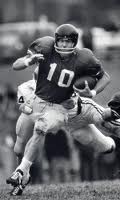
Franchise QB Bobby Douglass
1970: Bears experiment with leaving the defense on the field for one entire game, since they are more capable of scoring than the offense. Butkus is ineffectual at QB, but no one will tell him. Sayers comes back from knee injury to lead the NFL in rushing, despite playing behind an offensive line defenses refer to as “The Red Carpet.”
1971: In the draft, the Bears pass over linebacker Jack Ham for running back Joe Moore, who will go on to rush for nearly 300 yards in his NFL career. Gale Sayers suffers his second knee injury and football is never the same.
1972: Bears pass over Franco Harris to draft offensive lineman Lionel Antoine. Dick Butkus leads the team in every defensive category despite having had his knees removed in the off-season. Bobby Douglas rushes for nearly 1,000 yards, most of them with his helmet ripped off.
1973: Bears draft Gary Huff to end their quarterback woes.

Franchise QB Gary Huff
1974: Bears pass over Lynn Swann and Jack Lambert for Raymond Bryant and Dave Gallagher. Halas complains about the rising cost of player salaries: “Soon, I’ll be out over $100 a week!” Rumors surface that the Bears score a touchdown via something called the “forward pass,” but this in unconfirmed.
1975: Bears draft Wayne Wheeler over John Stallworth; however, the Bears also draft running back Walter Payton, who declares he’ll make fans forget about Gale Sayers. We don’t, but we’ll never forget Sweetness, either.
1976-1978: In three seasons, QB Bob Avellini manages to throw for more yards than Payton rushes–barely. Bears hire Neill Armstrong as their head coach, figuring if he can walk on the moon, he can do anything.
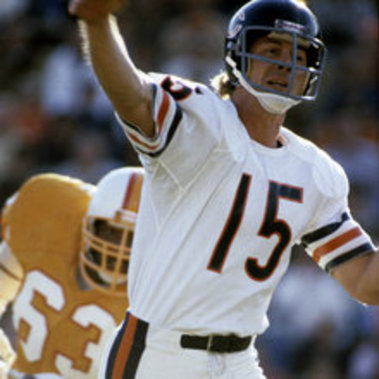
Franchise QB Mike Phipps
1979: Bears pick up franchise QB Mike Phipps. At last, their quarterback woes are over. Phipps passes for more TDs than INTs (by one), prompting Bears fans to check the NFL rulebook to see if that’s legal.
1980-81: Bears bring in QB Vince Evans, who manages to throw half as many TDs as INTs.

Franchise QB Vince Evans
1982: Bears select Mike Ditka as their head coach. Ditka causes controversy by slapping a player in the locker room with his glove and threatening to shoot him unless he gets back on the field. Bears also pick up franchise QB Jim McMahon. Finally, their QB woes are over.
1983: Bears finish at .500. Downtown Chicago closes for ticker-tape parade.
1984: Bears win division for first time since Hoover Administration. Not really, but it sure as hell seems like it.
1985: The Chicago Bears field the most feared team in football history. Quarterbacks throughout the league have their life insurance suddenly cancelled. In their three playoff games, the Bears outscore opponents 89-3 while the first-team defense is on the field. (The three points come after a lost fumble deep in their own territory.) Sorry, Miami: THIS is the greatest team in the Super Bowl era. Since the Bears have the 2nd-youngest team in the NFL, it will no doubt be the first of many championships over the next two decades.
1986: In a bitter divorce settlement, Buddy Ryan gets the Bears 46 defense. Bears win about three dozen games but lose at home in the playoffs.
1987: See 1986.
1988: See 1987.
1989: Bears trade McMahon, but they draft future franchise QB Jim Harbaugh to keep their quarterback woes at bay. Starting QB Mike Tomczak bets he can lead the Bears to the playoffs.

Franchise QB Jim Harbaugh
1990: The Bears return to the winning column behind Harbaugh who throws for 10 TDs, one of the highest totals in Bears history.
1991-1993: Bears success is short-lived, and soon they slide into mediocrity, despite hiring new coach Dave Wannstedt and his mustache.
1994: Bears acquire #1 pick Steve Walsh as their franchise QB. At last, their QB woes are over. Walsh quickly matches Harbaugh’s record of 10 TD passes in a single year.

Franchise QB Steve Walsh
1995: Bears acquire Lion’s QB Erik Kramer to end their QB woes. Amazingly, he turns out to be good.
1996-97: Kramer turns out to be not all that good.
1999: Bears start QBs Shane Matthews, Cade McNown, and Jim Miller in an attempt to end their quarterback woes.
2000: The Bears ring in the millennium by finishing dead last in the division. On the bright side, QBs Cade McNown and Shane Matthews throw nearly a dozen TD passes and end with a passing rating well into double-digits.
2001: Lowly draft pick QB Jim Miller leads Bears to 13-3 season. A championship is clearly just around the corner.
2002: Lowly draft pick Jim Miller leads Bears to 4-12 season. A championship might not be just around the corner.
2003: To end their QB woes, Bears acquire 2nd-round pick Kordell Stewart. Unfortunately, off-season physical reveals Stewart suffers from Bukich Eye Disease.
2004: Bears hire head coach Lovie Smith, figuring any man named “Lovie” has got to be tough. Combined, the slew of starting Bears QBs bring back memories of the glory days of the 1970s quarterbacks.
2005: Bears draft franchise quarterback Rex Grossman in first round to end their QB woes. And sure enough, the Bears win the division behind Kyle Orton, who comes within one pass of the magic 10 touchdown throws for a season.
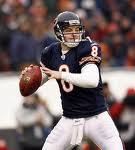
Franchise QB Rex Grossman
2006: Grossman returns and leads the Bears to a loss in the Super Bowl. Return man Devin Hester accounts for 104% of Bears scoring for the season. Clearly, a championship is just around the corner.
2007: Rex Grossman and Brian Griese combine to lead the Bears to 3rd-place finish in division. Off-season physical reveals Grossman suffers from Intermittent Bukich Eye Disease.
2008: Grossman is benched for Kyle Orton, who Lovie Smith has realized is still on the team. Midway through one of the NFL’s toughest schedules, the Bears are near the top of the league in scoring and would be undefeated, except the coaches feel bad about winning close games. Orton’s stats drop precipitously when he plays the 2nd half of season missing one leg. The Bears lose the last game of the season–and their playoff spot–when the defense shows up at Soldier Field instead of Houston, where the game is being played.
2009: The Bears trade their starting QB, three high draft picks, and $800 million in Federal stimulus money to acquire Denver Franchise Quarterback Jay Cutler. This time, their QB woes are definitely, absolutely, guaranteed to be over. In his debut, Cutler throws interceptions to Packers defensive backs, defensive linemen, and a hot dog vendor. As punishment, the Bears break with a hundred years of tradition and extend Cutler’s contract (which has three years remaining) until “forever,” adding a signing bonus of a reported jillion dollars and agreeing to rename the team, “SuperJay and da Boyz.”
The Bears’ disappointing season continues and rumors swirl that Cutler suffers from Bukich Eye Disease. It turns out to be something far worse: Cutler Syndrome–a combination of bad eyesight, color blindness, excessive ego, overconfidence, and WTF. Cutler leads the Superbowl-favored Bears to a losing season against the NFL’s weakest schedule, leading the league in interceptions, red zone turnovers, winnable games thrown away, pouting–and, of course, salary. On the plus side, he throws several touchdowns, a couple of them even outside the ten-yard line.
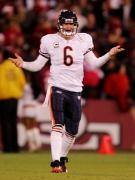
Ultimate Franchise QB Jay "WTF" Cutler
When the dust settles, Cutler has thrown more interceptions than any Bears quarterback since the middle of the Truman Administration (actual fact). This includes starters Mike Phipps, Vince Evans, Bob Avellini, Jim McMahon, Steve Fuller, Rusty Lisch, Greg Landry, Mike Tomczak, Doug Flutie, Jim Harbaugh, Peter Tom Willis, Will Furrer, Erik Kramer, Steve Walsh, Dave Kreig, Rick Mirer, Steve Stenstrom, Moses Moreno, Shane Matthews, Cade McNown, Jim Miller, Chris Chandler, Henry Burris, Kordell Stewart, Jonathan Quinn, Craig Krenzel, Chad Hutchinson, Rex Grossman, Kyle Orton, and Bob Griese–plus all the quarterbacks for thirty years prior to the start of this list.
And yes, even more than Rudy Bukich, who is reportedly delighted that Cutler joined the team.

New Bears QB Tryout Drill
